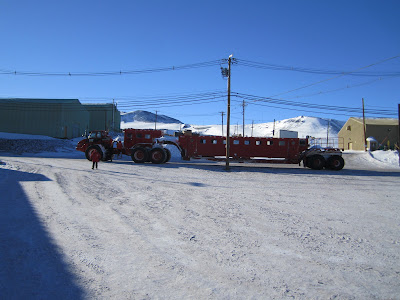Since I am in the southern hemisphere, spring is arriving. It has been a long dark cold winter and now the sun is up all day and the weather is warming gradually. The edge of the ice is still over 15 miles away, but that is decreasing every day. It is hard to imagine that there will be open water around the station and McMurdo sound will be full of wildlife in a little over a month. Though we do get some brutal spring storms here, the weather is generally much nicer. There have been four emperor penguins out wandering around and they are believed to be juveniles or females who haven't mated and are looking for a new colony. The seals are here year round, but now they are out sunning themselves. They are Weddell seals and are quite adorable. They have big puppy eyes. These seals do not eat the penguins, they live on little fish. When the ice starts to crack they use their teeth to "chew" a large enough hole to crawl through and they keep that breathing hole from freezing back over.
 |
| The seals come out between the pressure ridges and sun themselves. |
 |
| Aren't they cuties?? |
 |
| This seal came up to peek inside the dive hut. They will use any opening for a breath hole. |
The only other wildlife around here this time of year is the skua birds. They are a scavenger type bird, similar to a seagull, but larger. They get a bad reputation because there is little to eat here, so we must keep any of our food waste in a tightly closed container. They will see you carrying a piece of food and fly into you and grab it. Yep, they can be quite aggressive. We are not allowed to touch them in any way or disturb them, which can get tricky sometimes.
 |
| First skua sighting of the season |





































